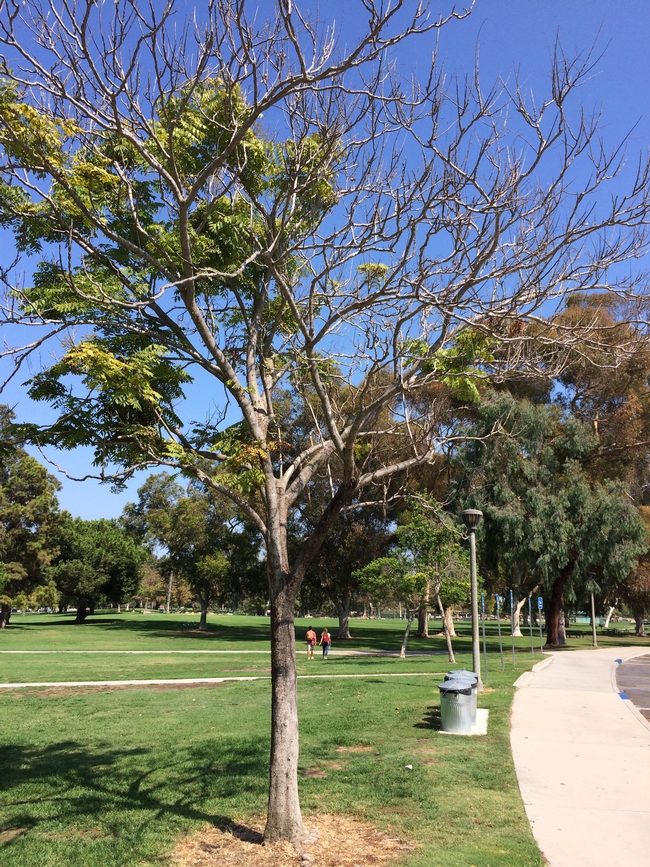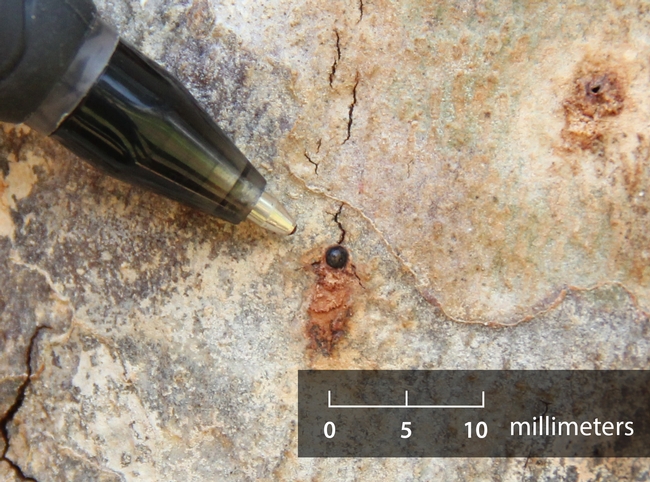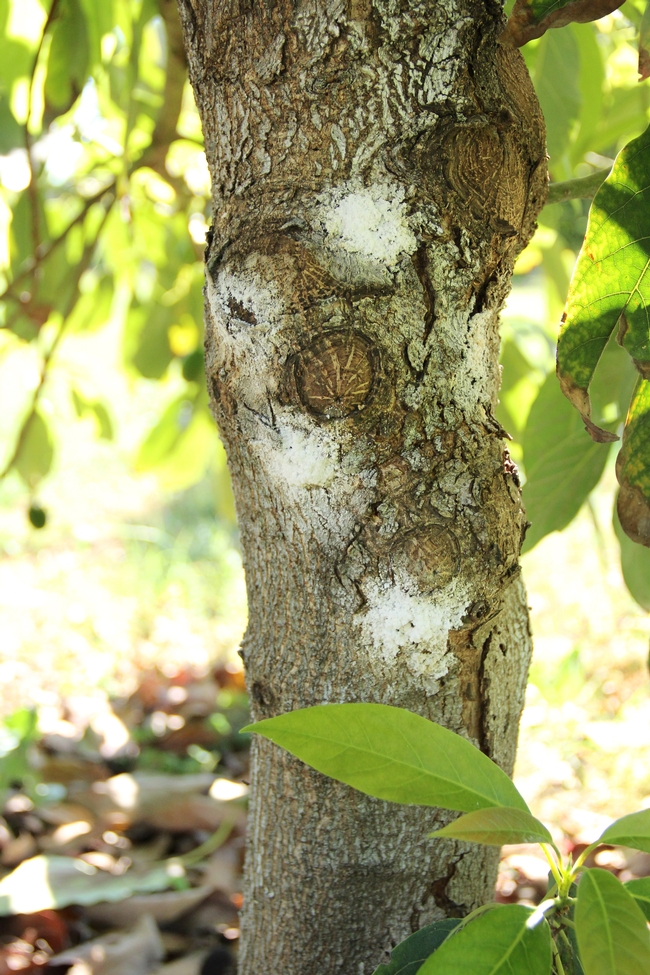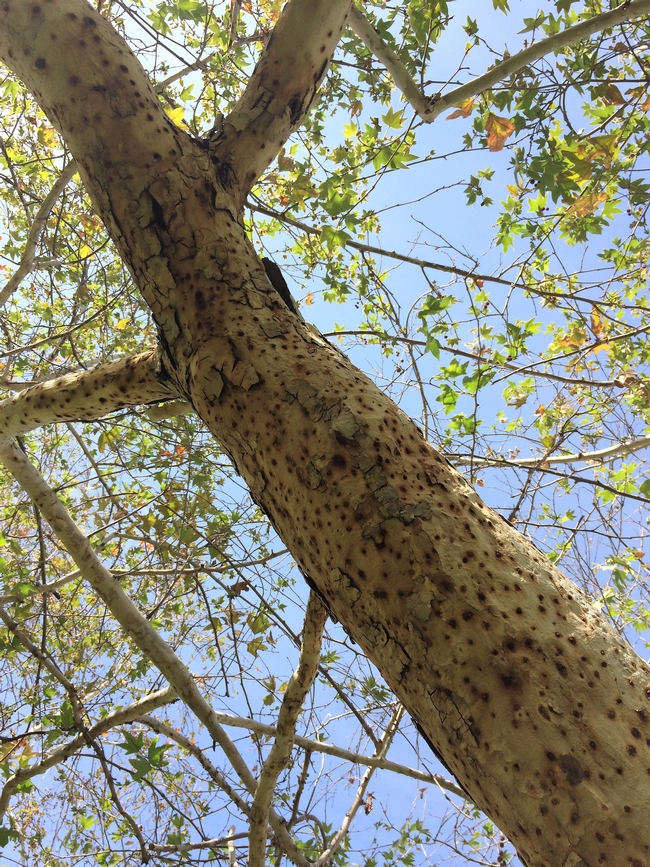[Originally published in the Fall 2018 issue of the Green Bulletin. Modified slightly from original.]
Invasive wood-boring beetles are attacking hundreds of thousands of trees in southern California, including commercial avocados, and trees within urban landscapes and wildland environments.
The invasive shot hole borers (ISHBs) consist of two closely related and morphologically identical species of beetles in the genus Euwallacea: the polyphagous shot hole borer and the Kuroshio shot hole borer. Despite their small size (1.8–2.5 mm) (Figure 1), these beetles are causing big problems in Southern California: they are responsible for the fast decline and death of thousands of urban trees, riparian natural forests, and avocado groves.
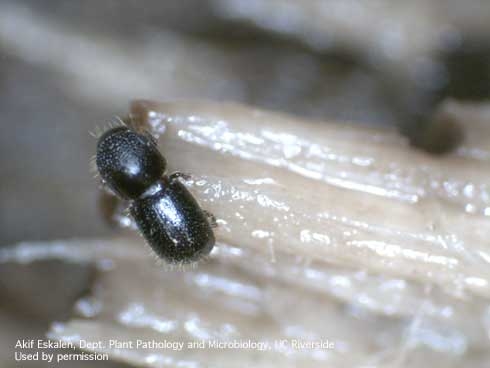
The beetles bore into trees, creating a series of small galleries (Figure 2). Inside these galleries, they lay eggs and “farm” a fungus (Fusarium spp.), which is their main food source. The fungus colonizes the trees' vascular systems, blocking transport of water and nutrients. This causes a disease called Fusarium dieback that manifests as branch dieback, general tree decline and, in many cases, tree death (Figure 3).
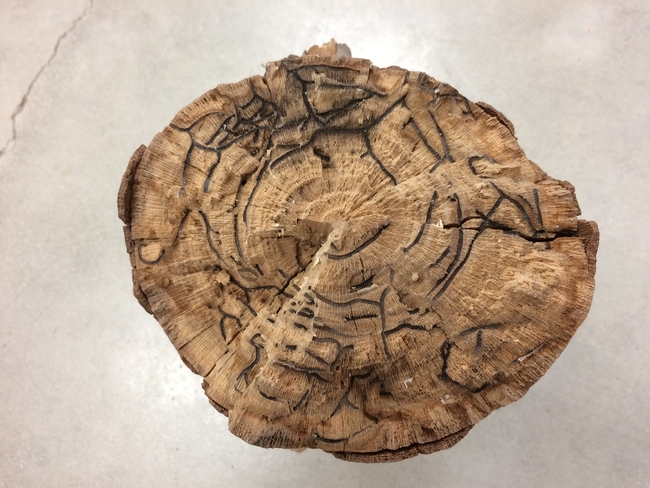
Both insect species are believed to have been accidentally introduced into California via wood products or shipping materials from southeast Asia. Since ISHBs were first identified in Los Angeles County in 2012, the infestation has spread to 6 other counties: Orange, San Diego, Ventura, Santa Barbara, San Bernardino, and Riverside. Once the beetles arrive at a new location, they colonize susceptible host trees and spread to neighboring areas, infesting more and more trees. Movement of infested firewood and green waste are additional ways the beetles may be transported, allowing them to colonize new areas.
Currently, there are 64 confirmed species of trees in which the beetles can successfully grow their fungus and complete their life cycle. Susceptible trees include many of the species commonly used for landscaping; like sycamores, oaks, cottonwoods, and box elder, among many others. UC Riverside researchers found that ISHBs can successfully colonize trees that were previously considered non-suitable hosts by entering and reproducing in canker-infested branches. Canker is another tree disease caused by fungal or bacterial pathogens that enter the tree through open wounds; it typically causes localized dead areas on the trunks and branches, with sunken, discolored bark and, sometimes, dark lesions.The ISHB beetles can establish their galleries and grow their population in the weakened margin of the canker-infested tissue of some of their hosts. Regular monitoring and removal of canker-infested branches is recommended for these tree species. To find the full list of ISHB reproductive hosts (including the canker-associated hosts) please visit pshb.org.
How do you determine if a tree is infested with ISHB?
Correct identification of the pest is the first step for a successful IPM program. The following are typical symptoms of an ISHB infestation:
- Beetle entry holes: When the beetles excavate their galleries in the trees they make perfectly round small holes, 0.8 mm wide, each roughly the size of the tip of a medium ballpoint pen. (Figure 4)
- Symptoms associated with holes: Entry holes are usually accompanied by one of these symptoms: wet staining, gumming (Figure 5), white powdery exudate (Figure 6), or frass (boring dust). Each species of tree exhibits different symptoms.
- Dieback: Dead or wilting branches can be signs of a severe infestation. If you see dieback on your trees, check for entry holes on the branches or the branch collar.
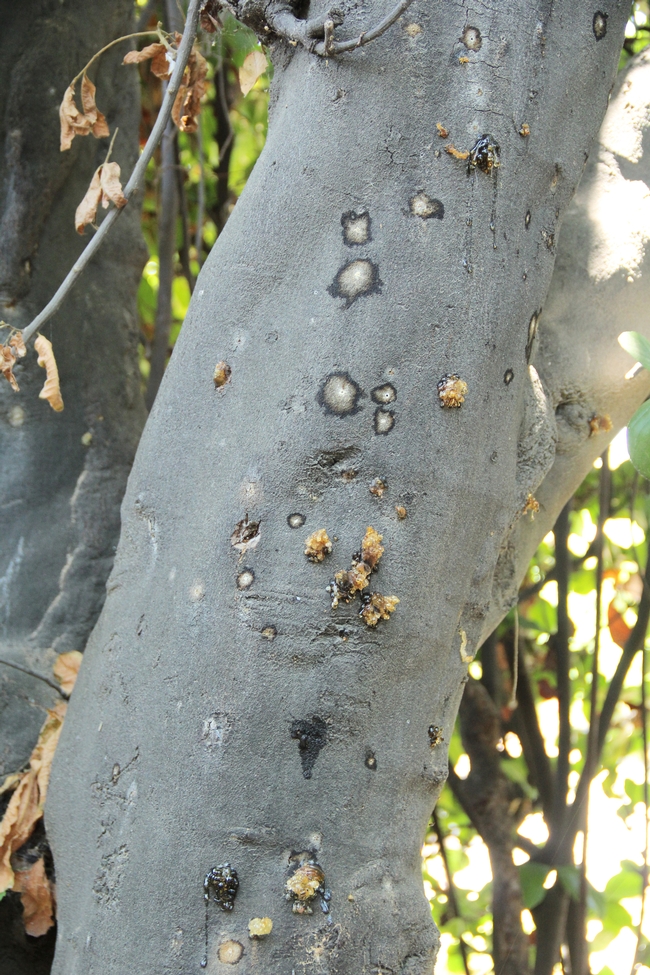
Best management practices
ISHB-infested trees can quickly become a public safety hazard. Trees with heavily infested branches are especially hazardous, since the combination of tissue decline caused by the fungal pathogen and the mechanical damage from the beetle's galleries weakens the wood, causing limbs to break and fall.
Early detection is the key to controlling this pest. So far, no effective preventative treatments have been reported, so regular monitoring is recommended to ensure infestations are managed early, before they cause dieback or death. Regular monitoring also ensures that trees get treated when they are lightly infested and have the most chances of overcoming the infestation. Researchers continue to study different methods for chemical and biological control of this pest. If you suspect you are dealing with an ISHB infestation, contact your local Agricultural Commissioner's office or IPM Advisor for treatment advice.
Trees that are severely infested (with more than 150 beetle attacks and ISHB-related branch dieback; Figure 7) are not likely to recover from the infestation and will become a constant source of beetles that can disperse and infest neighboring trees. Furthermore, weakened branches on such trees pose hazards to people and property. Therefore, severely infested trees should be removed as soon as possible and their wood properly disposed of. Even after an infested tree is removed, ISHBs can continue to live and reproduce in the stump, so following tree removal with stump grinding is always recommended.
Disposing of infested wood
Borers can survive in cut wood for weeks or even months. It is vital to take care of green waste appropriately in order to avoid spreading this pest to new areas. The most recommended practice is to chip infested wood to a size of 1 inch or smaller; this will kill 95% of the beetles. To ensure the elimination of all beetles and fungal spores within wood, you must solarize infested wood chips with a clear tarp. Other effective disposal methods for infested materials include composting, burning at a biogeneration facility, and use as alternative daily cover within landfills. Untreated chips can be used as mulch, but only in areas that are already heavily infested with ISHB. If chipping is not possible, logs should be kiln dried or solarized under a clear tarp to ensure total beetle elimination. Visit pshb.org for more information on solarization and composting guidelines.
ISHB and its associated fungal diseases can be accidentally spread into new areas by the same people who are trying to manage the problem. Make sure you disinfect your tools after pruning (spraying them with 70% ethanol solution works well), and always cover infested material when moving it to a different location (for instance, for treatment) to avoid spreading the pest.
